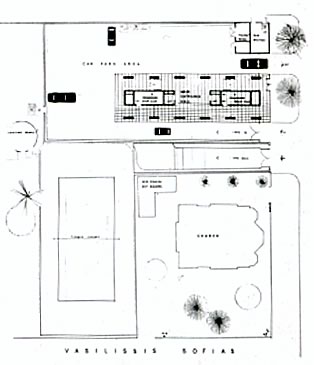
British Embassy
1 Ploutarchou and Ypsilantou Sts, Athens, 1967-69
Architect
E. Bedford (1933-)
Associate architects
Ioannis Antoniadis
Evangelos Vassiliadis
The British Embassy is one of the very few diplomatic
missions in Athens housed in a modern building; it is also the second
most important embassy after that of the United States. This is a typical
example of the international brutalist current of the 1960s, designed
by E. Bedford, head of the Architectural Services of the British Ministry
of Public Buildings and Works, in collaboration with the Greek architects
I. Antoniadis and E. Vassiliadis.
The Embassy building is located in the central district of Kolonaki
at the intersection of Ploutarchou and Ypsilantou Sts, adjacent to the
eclecticist residence of the Ambassador of Great Britain (former home
of Eleftherios Venizelos, 1930-32, architect Anastasios Metaxas) and
the neo-Byzantine church of St Nicholas.
It consists of a ground floor, mezzanine, four floors and a basement.
On the ground floor, the volume of the building is limited and includes
the entrance on the east side, the vertical circulation core, and the
auxiliary and parking spaces that extend into the basement. The second
floor houses the commercial section, reception and exhibition areas.
The load-bearing features are of reinforced concrete. The pillars supporting
the ground floor outside the core bear only the ground-floor slab. The
slabs of the remaining floors are cantilevered and rest on the core
of the building along the main elevations on both sides of the main
axis.
The lengthwise elevations are treated with a rectangular grid of reinforced
concrete, while the narrow sides of the building are faced with Pentelic
marble. The materials used on the ground floor are grey Chios marble,
bare concrete, glass and aluminium.
TRANSPORTATION
